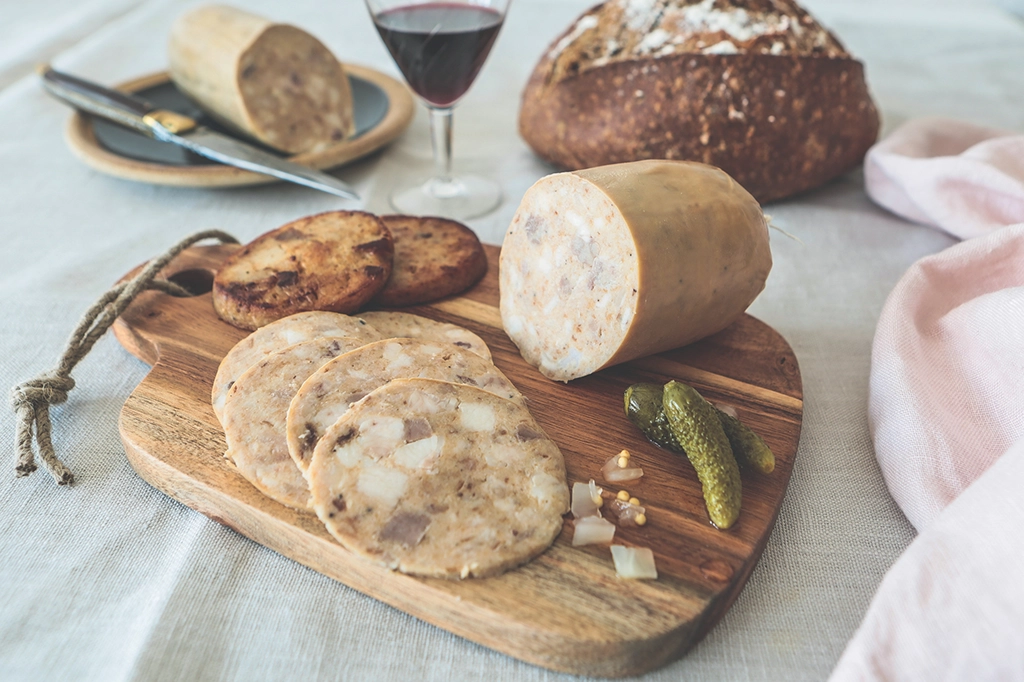History & Culture, New Products
Discovering Melsat: A Hidden Delicacy from South-East Tarn
🇫🇷 What Is Melsat? A Southern French Sausage with a Story
Deep in the rolling hills of South-East Tarn, in southern France, lies a culinary secret rarely known outside the region: the Melsat. It’s a traditional sausage, pale in color, soft in texture, and rich in flavor — and it tells the story of a region that values no waste, authenticity, and craftsmanship.
Unlike the robust red sausages of Toulouse or the spiced versions from Alsace, Melsat is a white pork sausage. At first glance, it may surprise with its appearance: more delicate in color, more tender on the palate, and far less known than its cousins. Yet behind this modest look lies a culinary treasure that embodies the peasant ingenuity of the Occitan region.

🧬 The Origins: From Rural Necessity to Regional Pride
The name Melsat comes from the Occitan word “melhat”, which roughly means “mixed” or “combined”. It refers to the mixture of meat, fat, and bread that make up its unique recipe. Born in a time when nothing was wasted, Melsat was created to use less noble parts of the pig, combined with white bread and spices to form a nourishing and satisfying dish.
Historically, Melsat was made during the pig slaughter season (“la tuaille” in Occitan), an important event in rural communities. Families gathered to butcher the animal and preserve every part of it. Hams and cured sausages were kept for long-term storage, while the more perishable parts — such as pork throat, lungs, or fat — were transformed into recipes like boudin, fritons, and Melsat.
Though it was once a purely domestic preparation, some artisan charcutiers in the Tarn and Aveyron regions have kept the tradition alive. Today, Melsat is protected as a regional specialty and served in both farmhouse kitchens and fine restaurants.
🐽 What’s Inside a Melsat?
The recipe can vary slightly depending on the village or the family, but a traditional Melsat usually contains:
- Pork meat and fat (often pork throat, pork belly, or shoulder)
- Day-old white bread or breadcrumbs
- Eggs (to bind the mixture)
- Salt and pepper
- Nutmeg or other mild spices
- Sometimes milk or onions are added for a smoother texture
This mixture is finely chopped and emulsified, then stuffed into natural casings, tied by hand, and gently cooked — but not smoked or dried. This gives it a moist and soft consistency, somewhere between a white sausage and a fine pâté.
It’s important to note: Melsat is not raw, but pre-cooked, and should be kept refrigerated. It’s eaten either cold or grilled, depending on the dish and the mood.
🍴 How to Eat Melsat: Culinary Ideas
Whether you’re a curious gourmand or a home cook looking for something new, Melsat is a versatile ingredient. Its subtle flavor and soft texture make it easy to pair with various dishes. Here are some delicious ways to enjoy Melsat, both in French tradition and with a touch of Taiwanese inspiration.
1. Pan-Fried Melsat with Lentils
This is perhaps the most traditional way to enjoy Melsat. Slices are pan-fried until golden, and served over a warm bed of green Puy lentils, lightly dressed with mustard vinaigrette. The contrast of crispy edges and creamy inside is simply delightful.
2. Melsat and Eggs (Occitan Breakfast)
Slice the Melsat and gently heat it in a pan. Serve it with scrambled eggs and toasted baguette for a rustic breakfast. You can add black pepper and herbs like chives or parsley.
3. Melsat Bao (Taiwan Twist!)
Inspired by gua bao, use Melsat slices as your filling! Gently pan-fry until golden, then place in a steamed bao bun with pickled daikon, coriander, and sweet chili sauce. It’s a surprising fusion that works incredibly well.
4. Cold Cuts Platter
Serve Melsat cold, sliced, alongside other charcuterie like saucisson, ham, and pâté, with cornichons and mustard. It pairs perfectly with a glass of Gaillac white wine — and makes for an elegant starter at any dinner.
5. Melsat Fried Rice (米香香炒飯)
Cut Melsat into small cubes and fry with garlic, eggs, and day-old rice. Add spring onions and a touch of soy sauce. The creamy pork sausage adds unexpected richness to this Taiwanese classic.

🍷 What to Drink with Melsat?
Melsat has a soft, creamy taste — think of something between liver pâté and white sausage — so you want to pair it with wines that complement its smooth texture and subtle spices.
- White wine from Gaillac (like Mauzac or Viognier): fresh, with apple and floral notes
- Light red wine, like a Gamay or Cinsault: delicate enough to not overpower the sausage
- Natural wines: especially pet-nats or skin-contact whites, which add complexity to the pairing
For a non-alcoholic pairing, go with sparkling water with lemon, or cold oolong tea to cut through the fat and refresh the palate.
📦 How We Source Our Melsat
At Yueh’s Choice, we partner with a small artisan charcutier near Mazamet, in the heart of the Tarn. This family-owned business has been making Melsat and other regional delicacies for over 60 years, using free-range pork and traditional recipes.
🧠 Frequently Asked Questions (FAQ)
No — while both are pale sausages, boudin blanc contains more milk and is usually finer in texture. Melsat uses more bread and fat, and has a slightly coarser, more rustic texture.
Absolutely! Melsat is fully cooked, and can be eaten cold, sliced thin, like a pâté. But it’s also delicious warm.
No — Melsat is mildly seasoned with salt, pepper, and sometimes nutmeg. It’s gentle and kid-friendly.
No — Melsat is made entirely from pork meat and fat, so it is not suitable for vegetarians.
💬 Final Thoughts: Bringing Tarn to Taiwan
Melsat is not just food — it’s a cultural symbol of the South of France, a product born from necessity and elevated by tradition. For us at Yueh’s Choice, sharing this little-known gem with Taiwan is part of our mission: to connect cultures through authentic, artisan-made French products.
If you’re curious to taste something new and delicious — something you won’t find in supermarkets or tourist shops — Melsat is a perfect discovery.
🛒 Coming Soon: Order Melsat on Yueh’s Choice
We are thrilled to announce that Melsat will soon be available on Yueh’s Choice by pre-order! Because of its fresh nature and artisan production, we will offer limited quantities on a monthly basis.
👉 Follow us on Instagram or Line to be notified when pre-orders open
👉 Product page will include full serving suggestions, wine pairings, and preparation tips
Stay tuned — and get ready to experience the taste of Tarn, one slice at a time.

